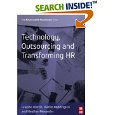I’m just about to begin a two-week stint running some courses and doing presentations on HR’s contribution to branding and reputation management in Australia and China. As always, I’m on the lookout for interesting material from academics to help me provide some insights into these important topics; hanging around airports and spending time on long plane journeys gives you plenty of time to do just that. So I brought with me the new edition of the Corporate Reputation Review (Volume 11, number3 for those interested). This special edition brings together leading people in the field of organizational identity to write about their emerging frameworks and data. In this increasingly arcane field, this special edition produces some gems. Though the papers are difficult to decipher, even for academics versed in the language of social identity and social actor theory, they yield some blindingly obvious-in-retrospect insights that cause me to re-think some of my ideas on employer branding, some research and consulting work we are doing in the field of employees’ images of healthcare organizations, and the nature of the HR.
The first is an examination of the well-worn distinction in the literature on reputation management between organizations’ needs to be simultaneously different and legitimate in terms of their organizational identities, the characteristics of which are their central, enduring and distinctive attributes (CEDs). Brayden King and Dave Whetten (the latter always a great bet for new insights) suggest that this ‘paradox of identity’ can be thought of in a rather different way than has hitherto been the case. Traditionally, this tension has been seen in terms of organizations attempting to solve seemingly incompatible needs for being different (i.e. branded) from competitors in product and labour markets but also being similar (social legitimate) to their comparators (e.g. being socially responsible, adhering to legal and governance standards, etc).
King and Whetten’s insight – rather obvious when you think about it - is that these needs are linked by the notion of ‘accountability standards’, which define norms of both appropriate behaviour (legitimacy) and esteemed performance (reputation).
Thus, when an organization seeks to become or remain a member of a business/ industry category, say a healthcare provider, it has to meet the minimum expectations of external and internal ‘audiences’ for patient care and the delivery of public value – the necessary, legitimacy-based conditions for membership. However, to become an esteemed member, it has to meet the ideal or aspirational standards of that group of businesses/ industry (reputation). The two, of course, are linked in the form of a continuum from minimum standards to ideal standards. And, because they are linked, changes in one have an impact on the other and vice versa. So, for example, as our expectations of the minimum standards of an employer change in relation to what might be expected, say, of an ‘employer of choice’, this leads to a ratcheting-up of our expectations of the ideal standards of an employer of choice - in other words, employer branding becomes a moving target. Similarly, as organizations compete harder to become employers of choice, such competition leads to a ratcheting-up of minimum standards. The probable results of this last dynamic is that the previously held ideal of an employer of choice becomes the the minimum table stakes, because audiences focus on, and increasingly use as their benchmarks, these prominent players in their industry and exclude reference to others.
Applying this line of thinking to the legitimacy and reputation of the HR function itself, you might be better able to understand how excellence in HR is no longer just associated with meeting the standards associated with cost control and service delivery to internal stakeholders, its two traditional and necessary functions (see Martin, Reddington and Alexander, 2008). Nor, we argue, is it good enough for HR to meet the aspirations of being ‘strategic’ (i.e. to contribute to corporate needs for innovation, customer satisfaction, productivity through high performance work systems, etc) , which has now become the prototypical expectation for HR excellence. Instead, HR needs to focus on the long term reputation and legitimacy of the organization itself by contributing to corporate branding, corporate governance and risk management, corporate social responsibility and ethics, and the creation of intellectual capital. These are all intangible assets, which, according to the well-known economist John Kay (2005), are the reason ‘why some nations are rich and others remain poor’.
The downside of this process, however, is that the market and competition over organizational and even professional identities leads to ever more risky behaviour, in much the same way that competition in financial services has seen firms develop riskier products and riskier HR strategies (talent management and bonuses). What will HR need to do next to help organizations become an employer of choice, and to become a function that rates high in the credibility stakes with CEOs?
The second article is by Kristin Price (who tragically died recently) and Dennis Gioia, both of whom featured in a recent blog. This time, their specific contribution is to raise the question: how can organisations improve their images in the marketplace for images – that is, among customers, employees, the media, prospective employees, shareholders, governments and the like? Building on their previous work on the notion of organizations having multiple, intended and unintended images, they propose the notion of the self monitoring organization. This concept is borrowed from the literature on individual differences. So just as high self monitoring individuals have to be vigilant about the multiple images of themselves (their own self concept, professional images, family members’ images etc), so high self monitoring organisations use a range of strategies and individuals to further the organization’s interests in reconciling self image with others’ images (the press, employees, prospective employees, shareholders, etc). Most of these are well known – brand ambassadors or even bloggers who are high in self-monitoring and become the eyes and ears of the organization, newcomers not yet socialised into the system, boundary spanning functions such as marketing, communications and, yes, and outward looking HR function, social networking and leadership liaison functions, which interact with outsiders, etc.
Two critical points emerge from this paper. The first is to expect multiple images in organisations and leadership difficulties in understanding them, especially if they aren’t high self monitoring as a group. The second is the problem of managing organizations with purposively different intended images, for example, a merger between two quite different companies even in the same industry. Both of these problems can be solved, to a degree at least, if organizations become high in self monitoring. As an afterthought, it in self-monitoring that Web 2.0 can make an enormous impact in helping act as the eyes and ears of the organization – another connection between technology and branding.





.jpg)

